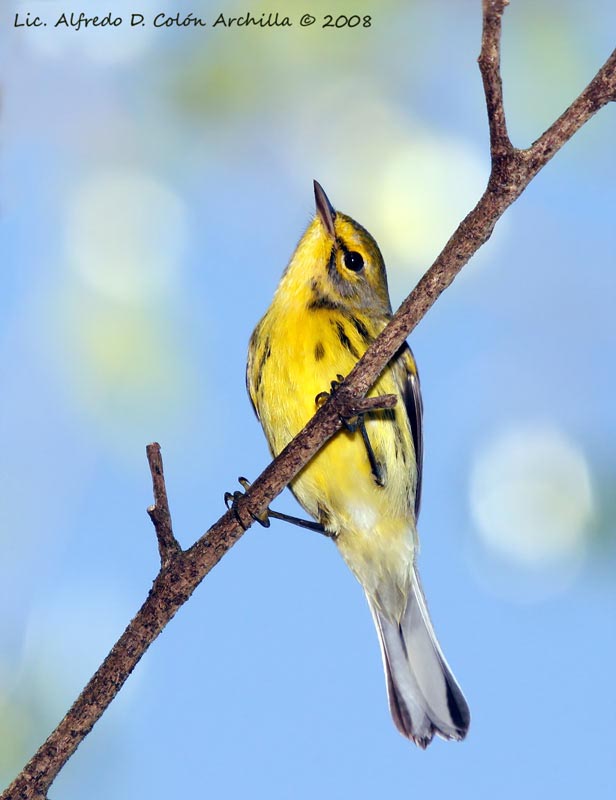
Prairie Warbler
Setophaga discolor
Passeriforme Order - Parulidae Family
BIOMETRICS:
Length: 11 cm; Wingspan: 19 cm; Weight: 6-9 g
LONGEVITY: 10 years
DESCRIPTION:
Prairie Warbler has olive-green upperparts with faint chestnut streaks on back. Underparts are bright yellow, streaked with black on sides of neck and body. We can see two indistinct wing bars.
It has a bright yellow eyebrow, and yellow patch below eye, bordered below by a dark stripe. Eyes are dark brown, and it has a dark line through eye. Legs are black. Tail shows large white spots on outer feathers.
Female and immature male are slightly duller.
Immature female is duller still, greyish-olive above. It has an indistinct whitish eye ring. Head is grey. Streaks are diffuse along sides.
VOICE: SOUNDS BY XENO-CANTO
Prairie Warbler’s song is distinctive. It is a rising series of buzzy “zee” notes, fast or slow. It is usually loud and consists of several, ranging from 4 to 20 discrete notes.
Calls are variable. Often, it is a rather musical “chip”.
HABITAT:
Contrary to what its name suggests, Prairie warbler does not live in prairies habitats. It prefers shrubby fields and regenerating forests. It is common in open woodlands, scrublands, over grown fields and mangroves swamps. It is rarely found in thick woods.
RANGE:
Prairie Warbler breeds from S Maine to S Missouri, southward to N Florida and E Texas. It is resident along Florida’s coasts.
It winters throughout Florida, Bermuda, Bahamas, Greater Antilles, and Virgin Islands. We can find it on Belize and Honduras’ coasts.
BEHAVIOUR:
Prairie Warbler usually forages in lower branches and bush, wagging its tail up and down. It gleans for leaves and branches, and it may hawk insects in the air. It searches among the leaves, slowly and carefully.
When the bird is distressed, it bobs its tail. Tail is moved quickly downward, and then, returned to its original position. There are long intervals between up and down motion.
This species behaviour includes threat and appeasement displays during which territorial males typically sing high on perches well into the morning.
The species living in Florida (Dendroica discolor paludicola), builds the nest over the water, living in mangrove swamps.
Prairie Warbler is monogamous, but occasionally polygamous.
FLIGHT:
Prairie Warbler has light and short flight, making an effort to rise to the height of 7 or 9 metres, and immediately sinking down to the grass or bushes.
REPRODUCTION:
Prairie Warbler’s nest is an open cup. It is located in a shrub or sapling, at about 3 metres above the ground.
Nest is made with plant fibres, grass and leaves, and other materials. It is lined with fine grasses, mosses, feathers or hair, and spider web. Nest is sometimes attached to 3 or 4 blades of tall grasses, or hangs between two small sprigs of a slender twig. Nest is built by female.
She lays 3 to 5 pale brownish or grey eggs, spotted with brown. Incubation lasts about 11 to 14 days, by female alone. Chicks hatch altricial, and fledge at about 8 to 11 days. Both parents feed them. Youngs are apt to leave the nest if discovered, when unable to fly. They follow their parents through the grass to be fed. Young remain dependants of parents for 35 to 50 days.
This species can produce occasionally two broods per season, and often breeds in loose colonies.
DIET:
Prairie Warbler feeds mostly on insects and spiders, but also takes molluscs and fruit or other vegetative matter.
PROTECTION / THREATS / STATUS:
Prairie Warbler is a host of Brown-headed Cowbird. Female warbler may desert its nest if parasitized, and cowbirds damage host eggs.
Habitat loss and fragmentation are two major threats for this species.
Puerto Rico : Reinita Galana
Fr: Paruline des prés
All: Rostscheitel-Waldsänger
Esp: Chipe Galano
Ital: Dendroica della prateria
Nd: Prairiezanger
Sd: Prärieskogssångare
Photographs by Alfredo Colón
Puerto Rico Wildlife
Text by Nicole Bouglouan
Sources:
FIELD GUIDE TO THE BIRDS OF NORTH AMERICA –National Geographic Society - ISBN: 0792274512
All About Birds (Cornell Lab of Ornithology)
Wikipedia (Wikipedia, The Free Encyclopedia)
What Bird-The ultimate Bird Guide (Mitchell Waite)
SORA Searchable Ornithological Research Archive (Blair O. Wolf)
Bird Web (Seattle Audubon Society)

